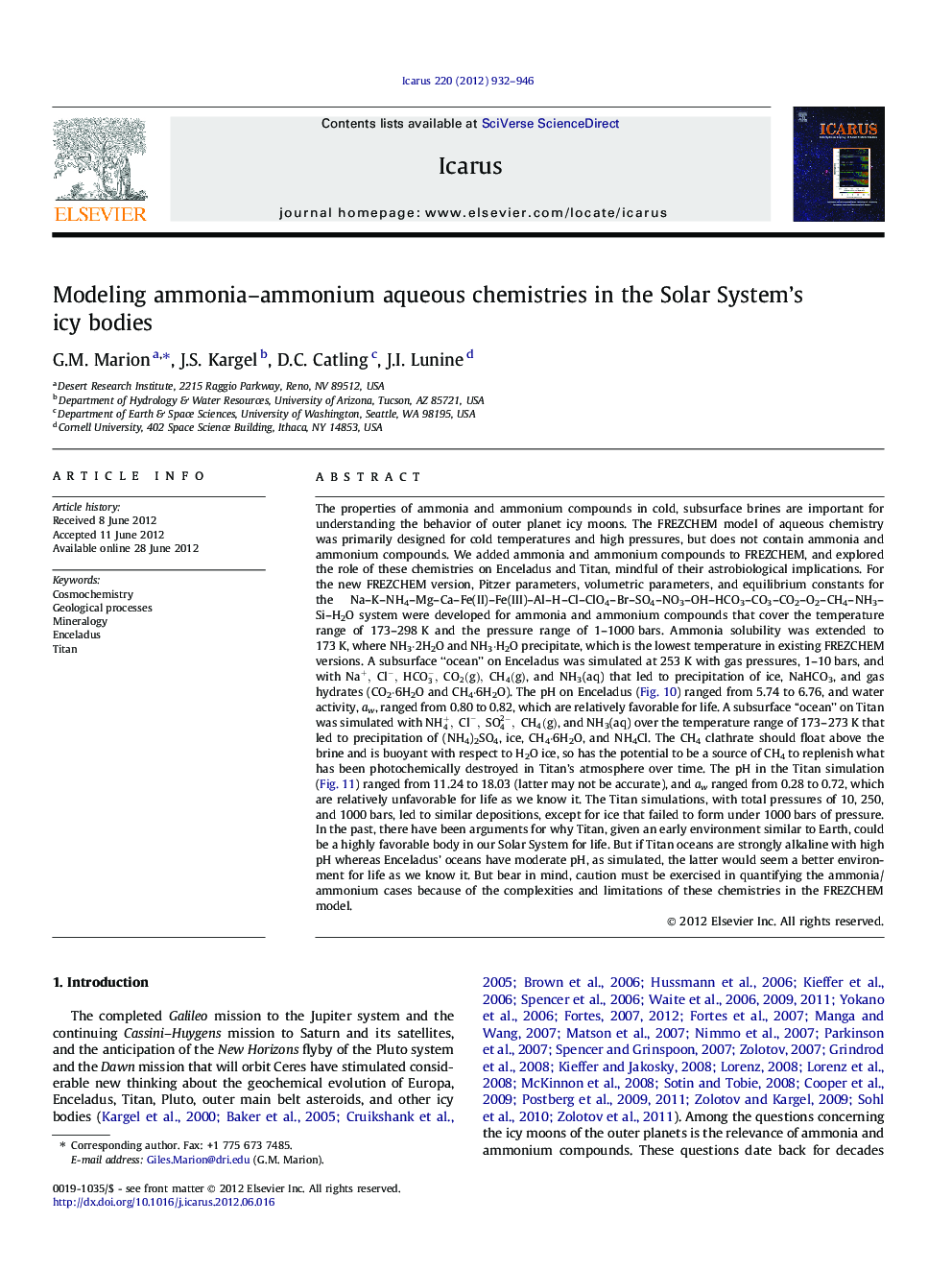| کد مقاله | کد نشریه | سال انتشار | مقاله انگلیسی | نسخه تمام متن |
|---|---|---|---|---|
| 1773455 | 1523564 | 2012 | 15 صفحه PDF | دانلود رایگان |

The properties of ammonia and ammonium compounds in cold, subsurface brines are important for understanding the behavior of outer planet icy moons. The FREZCHEM model of aqueous chemistry was primarily designed for cold temperatures and high pressures, but does not contain ammonia and ammonium compounds. We added ammonia and ammonium compounds to FREZCHEM, and explored the role of these chemistries on Enceladus and Titan, mindful of their astrobiological implications. For the new FREZCHEM version, Pitzer parameters, volumetric parameters, and equilibrium constants for the Na–K–NH4–Mg–Ca–Fe(II)–Fe(III)–Al–H–Cl–ClO4–Br–SO4–NO3–OH–HCO3–CO3–CO2–O2–CH4–NH3–Si–H2O system were developed for ammonia and ammonium compounds that cover the temperature range of 173–298 K and the pressure range of 1–1000 bars. Ammonia solubility was extended to 173 K, where NH3·2H2O and NH3·H2O precipitate, which is the lowest temperature in existing FREZCHEM versions. A subsurface “ocean” on Enceladus was simulated at 253 K with gas pressures, 1–10 bars, and with Na+,Cl-,HCO3-,CO2(g),CH4(g), and NH3(aq) that led to precipitation of ice, NaHCO3, and gas hydrates (CO2·6H2O and CH4·6H2O). The pH on Enceladus (Fig. 10) ranged from 5.74 to 6.76, and water activity, aw , ranged from 0.80 to 0.82, which are relatively favorable for life. A subsurface “ocean” on Titan was simulated with NH4+,Cl-,SO42-,CH4(g), and NH3(aq) over the temperature range of 173–273 K that led to precipitation of (NH4)2SO4, ice, CH4·6H2O, and NH4Cl. The CH4 clathrate should float above the brine and is buoyant with respect to H2O ice, so has the potential to be a source of CH4 to replenish what has been photochemically destroyed in Titan’s atmosphere over time. The pH in the Titan simulation (Fig. 11) ranged from 11.24 to 18.03 (latter may not be accurate), and aw ranged from 0.28 to 0.72, which are relatively unfavorable for life as we know it. The Titan simulations, with total pressures of 10, 250, and 1000 bars, led to similar depositions, except for ice that failed to form under 1000 bars of pressure. In the past, there have been arguments for why Titan, given an early environment similar to Earth, could be a highly favorable body in our Solar System for life. But if Titan oceans are strongly alkaline with high pH whereas Enceladus’ oceans have moderate pH, as simulated, the latter would seem a better environment for life as we know it. But bear in mind, caution must be exercised in quantifying the ammonia/ammonium cases because of the complexities and limitations of these chemistries in the FREZCHEM model.
► We model ammonia/ammonium chemistries for the FREZCHEM model.
► Simulations of Enceladus lead to gas hydrate formations at moderate pH (5.6–6.6).
► Simulations of Titan lead to gas hydrate formation at high pH (9.1–18.1).
► These simulations make Enceladus more favorable for life than Titan.
► Cautions must be exercised in quantifying the ammonia/ammonium cases.
Journal: Icarus - Volume 220, Issue 2, August 2012, Pages 932–946